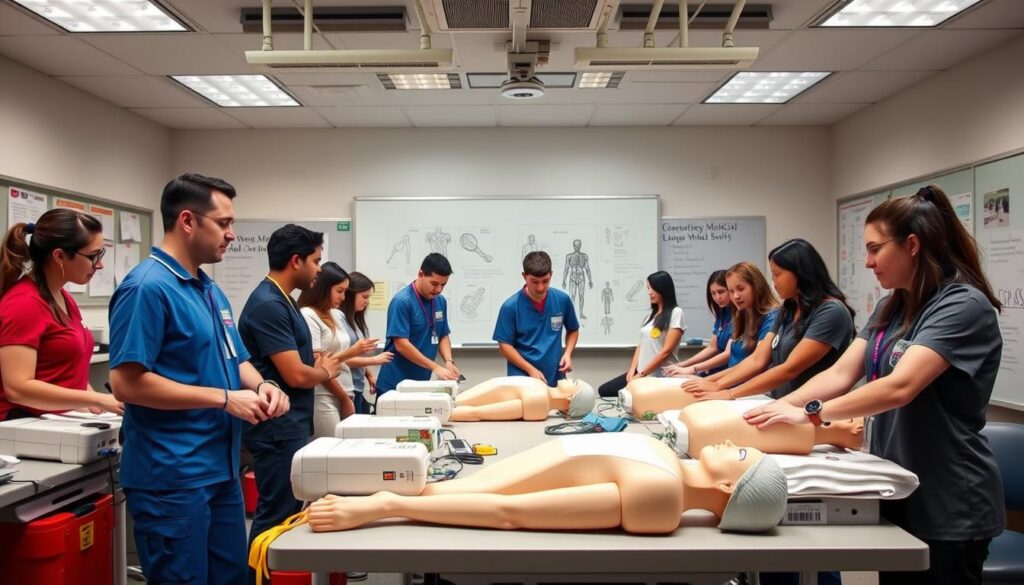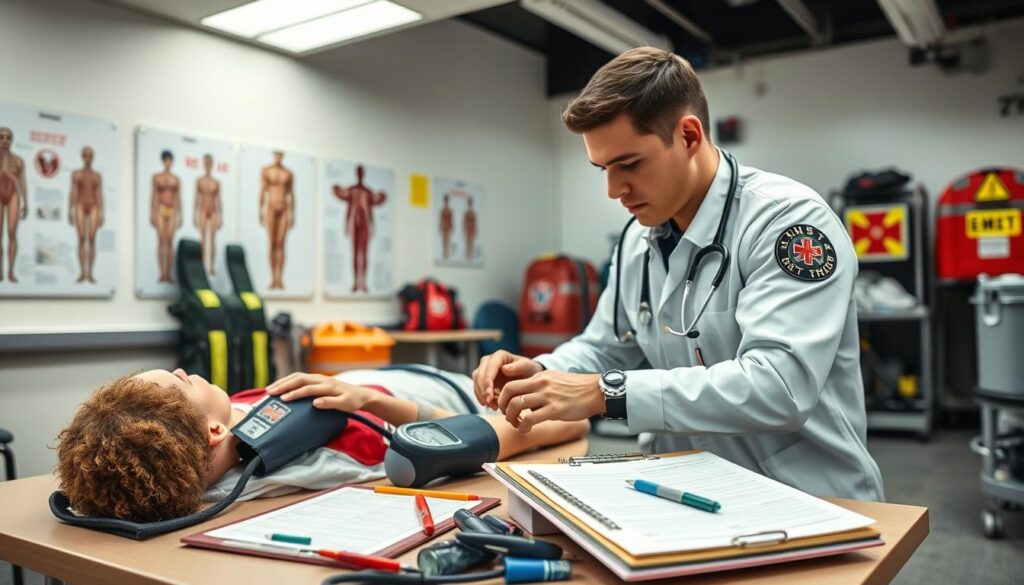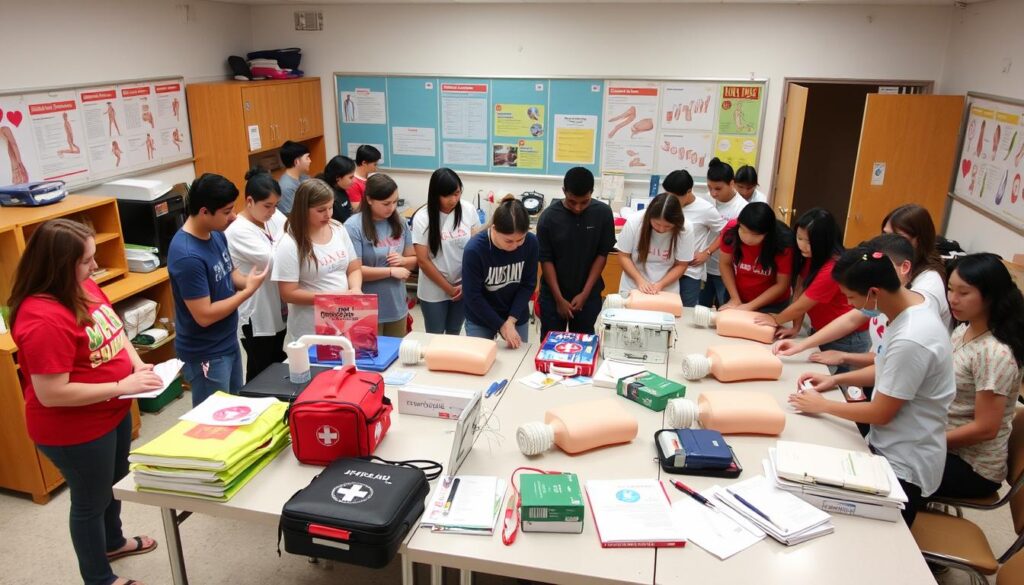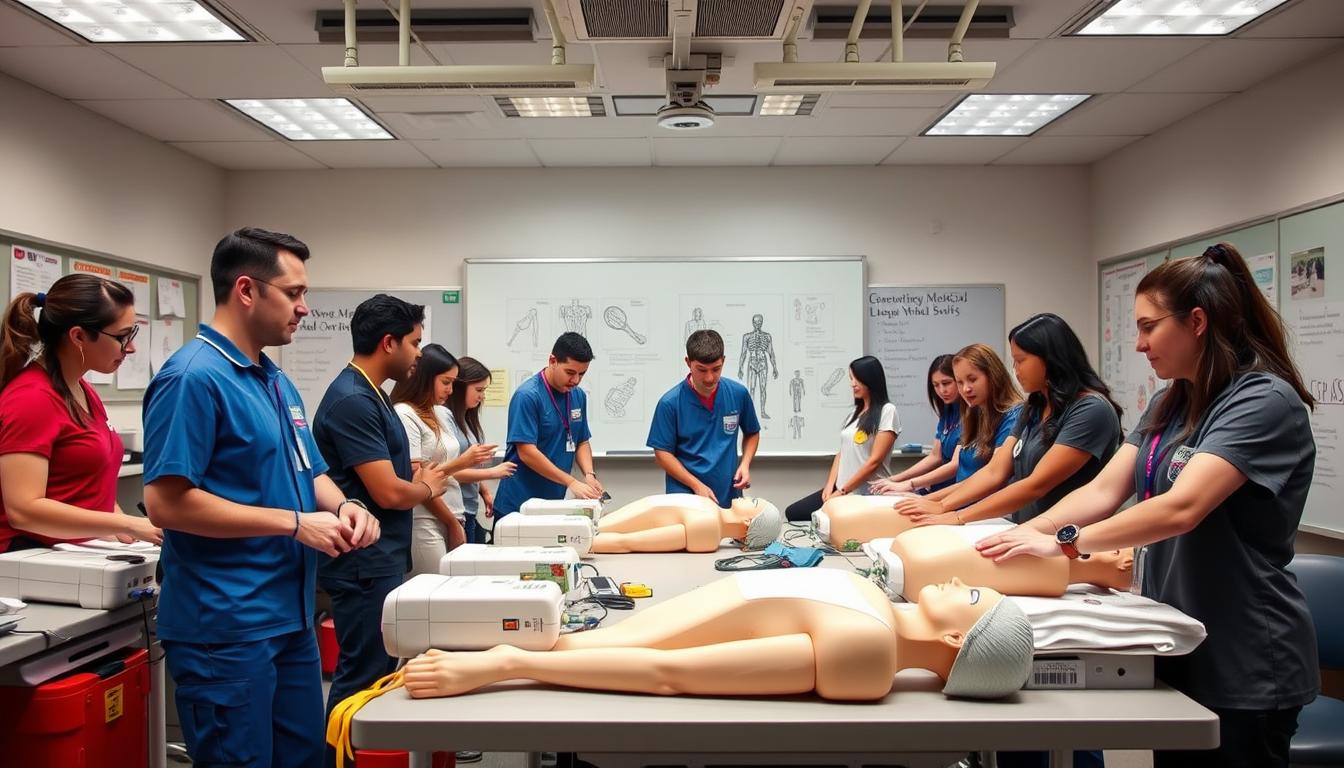The Emergency Medical Technology Course is a key step for those wanting to start a career in healthcare. It prepares students to become Emergency Medical Technicians (EMTs) or Paramedics. This course teaches vital skills and knowledge for emergency services.
It requires 220 clock hours for certification and offers dual credit options. This makes it easier for students to complete their training12. The program helps students become certified to handle medical emergencies well. It shows how crucial their role is in keeping communities healthy.
With online and virtual options, the course is flexible. It’s perfect for those who want to get an emergency medical services certification but have other commitments12.

Key Takeaways
- Emergency Medical Technology Course offers crucial skills for healthcare careers.
- Flexible training formats include online and dual credit options.
- Certification requires a total of 220 clock hours.
- Practical experiences are an integral part of the curriculum.
- Health assessments and background checks ensure student readiness.
Introduction to Emergency Medical Technology
Emergency Medical Technology is a system of emergency healthcare services. It aims to provide quick help to those facing medical issues. This field is key for keeping patients safe and getting them the help they need fast.
At the University of Arkansas for Medical Sciences, the Department of Emergency Medical Sciences (EMS) started in July 1975. This marked a big step forward in emergency healthcare training3. The EMT program has 6 semester credits, covering important topics in emergency medical technology3.
Classes for EMT training are designed to fit students’ needs. They meet two days a week for one semester. Sessions start every fall, spring, and summer3.
The Paramedic program offers two options: a Certificate or an Associate’s degree3. This program has a one-semester course with 7 units. It focuses on learning through both classroom and hands-on practicums4.
EMTs are trained to help patients on-site. They provide critical care until more help arrives. The success of emergency medical services is crucial for community health. It shows how important it is to have good training programs.
Why Choose an Emergency Medical Technology Course?
Choosing an emergency medical technology course offers many benefits. It can greatly impact your career and help your community. EMTs and paramedics play a key role in providing quick care during emergencies. This improves health outcomes and makes the healthcare system more effective.
Impact on Community Health
EMTs handle emergencies like car accidents and heart attacks. They address urgent health needs in communities. With a 5% growth in jobs from 2022 to 2032, the demand for EMTs is high5.
This shows how important EMTs are in healthcare. Their training prepares them for various situations. This makes the course a great choice for a career.
Job Market Demand
The job stability in EMS is strong, reflecting the critical nature of the work5. Graduates can find jobs as paramedics or first responders in hospitals and ambulances6. Medprime Training College offers a three-month course, allowing for quick entry into the field6.
This fast track to a rewarding career is attractive. There are also opportunities for advancement, like specialized roles in Critical Care Transport or Tactical EMT5.

| Statistical Data | Details |
|---|---|
| Projected Employment Growth | 5% from 2022 to 2032 |
| Time to Complete Course | 3 months at Medprime Training College |
| Total Program Cost | Ksh 49,500 |
| Entry Requirements | Minimum KCSE Grade D- |
| Career Opportunities | Paramedics, EMTs, First Responders |
Overview of EMT Programs
EMT programs are a great way to start a career in emergency medical services. They range from basic EMT training to advanced paramedic programs. This variety meets different career goals in the field.
Basic EMT and Advanced Paramedic Training
The basic EMT courses last about 21 days. They teach students the basics of patient care. The program structure can vary, like night courses lasting four weeks or morning courses for seven weeks7.
Advanced paramedic training takes longer, needing 1-2 years of study8. It covers more complex medical procedures, like cardiac management and intravenous therapy.
Course Formats: Online and In-Person Options
Today, emergency medical technician program options are more flexible. Schools offer online hybrid and in-person courses. For example, an online hybrid basic EMT program lasts 11 weeks with six on-site days7.
These formats help students fit their learning into their busy lives. It makes it easier to find a program that works for them.
Students must also know about ongoing requirements. In California, EMTs need to renew their state certification every two years7. A solid start in EMT programs prepares students for the challenges in emergency medical services.
Emergency Medical Technology Course: Curriculum Breakdown
The curriculum of an emergency medical technology course is key. It teaches students the skills and knowledge needed for emergency response. It covers both theory and practice.
Fundamental Courses and Their Importance
The emergency medical technology course curriculum starts with basics like Medical Terminology, Human Anatomy, and Clinical Skills. These subjects give students a solid foundation in pre-hospital care. They learn how to handle medical emergencies confidently.
Students also learn essential protocols. This knowledge is crucial for their roles as EMTs and paramedics.
Practical Experience Opportunities
Practical experience is just as important as theory in an EMT program. Students get hands-on training in clinical placements and simulation labs. This lets them apply what they’ve learned in real situations.
This mix of classroom learning and EMT training prepares students for emergency medical settings. They become ready to face challenges head-on.

| Course Component | Details |
|---|---|
| Basic Courses | Medical Terminology, Human Anatomy, Clinical Skills |
| Practical Training | Clinical Placements, Simulation Labs |
| Course Duration | Ranges from 10 to 12 weeks, varying by program |
| Certification Opportunities | BLS Certification, NREMT Review |
This structured curriculum makes the emergency medical technology course curriculum very effective. It prepares a well-trained workforce for emergency healthcare91011.
Required Qualifications for Enrollment
To join an emergency medical technology program, you must meet certain requirements. Knowing what’s needed is key to a smooth application. You’ll need to consider age limits, education, and health standards before starting.
Age and Educational Requirements
Most EMT programs want you to be at least 18 and have a high school diploma. These basics help you understand the program’s challenges. Not meeting these can cause big delays; up to 40% of students face issues starting or continuing12.
Health Assessments and Background Checks
Getting a health check is a big part of signing up. You’ll need to get shots for Hepatitis B, TDaP, MMR, Varicella, and Influenza. Some shots take up to seven months12. Also, background checks are common to ensure safety and ethics. These steps help prove you’re ready for the job.

Typical Duration and Structure of an EMT Course
EMT courses can last from a few months to two years, depending on the level. Basic EMT courses are about 150 hours. Advanced levels need around 400 hours. The Paramedic course, the most extensive, requires about 1200 hours of training13.
Most EMT programs mix classroom learning with practical training. For example, the EMT Paramedic certificate program has 16 courses. It totals 41 semester credit hours over three semesters, about a year14. This structure helps students learn the skills needed for the job.
Courses like Emergency Vehicle Driver Training and Tactical Emergency Casualty Care are part of the curriculum. The EMSVO course, for instance, teaches safe driving for emergency vehicles15. This diverse structure prepares students well for their future careers.
| Course Type | Duration | Semester Credit Hours |
|---|---|---|
| Basic EMT Course | 150 hours | Varies |
| Advanced EMT Course | 400 hours | Varies |
| Paramedic Course | 1200 hours | 41 hours |
| EMS Vehicle Training | 16 hours | N/A |
| Tactical Emergency Care | 16 hours | 16 CPC credits |
In summary, EMT programs are designed to give students a solid foundation. They learn the skills needed to handle emergencies efficiently.
Common Skills Acquired in EMT Training
EMT training teaches students many important skills for emergency medical response. They learn how to quickly check a patient’s condition to decide on treatment. This skill helps EMTs spot key signs and symptoms for the right care.
Critical Analysis and Patient Assessment
Being good at patient assessment is key in emergency medical services. EMTs learn to think critically and make quick decisions in stressful situations. This skill helps them focus on the most urgent medical needs, improving patient care.
They also learn to communicate well. This skill is crucial for talking to doctors and explaining things to patients and their families1617.
Life-saving Interventions and Protocols
EMT training covers life-saving skills like CPR and oxygen therapy. Knowing these protocols is vital for EMTs to act fast in emergencies. Their training helps them save lives by acting quickly.
EMTs also learn to stay calm in tough situations. This emotional strength is key for providing top-notch emergency care1718.
Cost of Emergency Medical Technology Programs
The cost of Emergency Medical Technology programs can vary a lot. It depends on the program and the school’s prices. On average, EMT programs cost about $1,220. This includes tuition and fees of around $1,020 and extra costs for books, uniforms, and supplies of about $30019.
For example, Mercy College’s program costs up to $2,150. This price includes textbooks and special courses20.
Students also need to think about ongoing costs. These include the cost of certification renewal every two to three years. This might require refresher training or continuing education courses. It’s important to consider these costs when planning your career20.
There are financial aid options to help with these costs. But, some programs might not qualify for all aid or scholarships. It’s crucial to research all financial aid for EMT training before you start. Many schools offer payment plans, grants, and scholarships to help students in these important roles21.
FAQ
What is the Emergency Medical Technology Course?
The Emergency Medical Technology Course is for those who want to be Emergency Medical Technicians (EMTs) or Paramedics. It teaches the skills and knowledge needed for emergency medical services. Students learn to get certified in this field.
What skills will I learn in an EMT course?
In an EMT course, you’ll learn important skills. These include patient assessment, CPR, oxygen therapy, and trauma management. These skills help make quick decisions in emergency situations to ensure the best patient care.
What are the qualifications needed to enroll in an emergency medical technology course?
To enroll, you must be at least 18, have a high school diploma or equivalent, and pass health checks. These include immunizations and drug screenings. Background checks are also needed to meet ethical standards in emergency services.
How long does it take to complete an EMT course?
EMT courses last from a few months to a year. Basic EMT programs usually take nine months. Advanced paramedic training can take up to two years.
What are the financial implications of pursuing an emergency medical technology program?
The cost of these programs varies, with tuition around $2,085 plus extra fees. There are financial aid options like scholarships and grants to help with costs.
Are there different formats for EMT and paramedic training courses?
Yes, there are flexible formats for EMT and paramedic training. You can choose online or in-person classes. This lets you pick what works best for your schedule and preferences.
What type of practical experience is included in EMT training?
EMT training includes clinical placements and simulation labs. These provide hands-on learning. It’s essential for applying skills in real emergency situations.
Source Links
- Emergency Medical Technology A.A.S. – Career Degree
- Accelerated Emergency Medical Technology (EMT)
- Emergency Medical Sciences
- Emergency Medical Technology
- 10 Reasons Why You Should Choose a Career as an EMT | Unitek EMT
- Emergency Medical Technology Course – MedPrime Training College
- CIEMT • California Institute of Medical Training – EMT (Emergency Medical Technician)
- Paramedic Schools & EMT Training | How To Become A Paramedic/EMT
- ADVANCED EMT | UPEMS
- Emergency Medical Technician – Basic Certificate – Career Certificate
- EMT Program Enrollment Requirements
- Top 10 Emergency Medical Technician Courses in the USA
- EMT Paramedic < UT Health San Antonio
- EMS Training Programs
- Emergency Medical Technician (EMT): Duties, Salary, and More
- Life Skills You Didn’t Expect to Learn as an EMT
- Career Advancement: How EMS Experience Opens Doors
- Emergency Medical Services | BSCTC
- Emergency Medical Technician Certificate
- Emergency Medical Services

